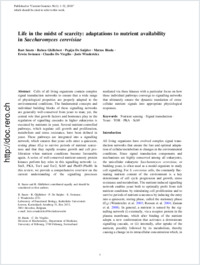Life in the midst of scarcity: adaptations to nutrient availability in Saccharomyces cerevisiae
- Smets, Bart Laboratory of Functional Biology, Katholieke Universiteit Leuven, Heverlee, Belgium
- Ghillebert, Ruben Laboratory of Functional Biology, Katholieke Universiteit Leuven, Heverlee, Belgium
- Snijder, Pepijn De Laboratory of Functional Biology, Katholieke Universiteit Leuven, Heverlee, Belgium
- Binda, Matteo Division of Biochemistry, Department of Medicine, University of Fribourg, Switzerland
- Swinnen, Erwin Laboratory of Functional Biology, Katholieke Universiteit Leuven, Heverlee, Belgium
- De Virgilio, Claudio Division of Biochemistry, Department of Medicine, University of Fribourg, Switzerland
- Winderickx, Joris Laboratory of Functional Biology, Katholieke Universiteit Leuven, Heverlee, Belgium
-
06.01.2010
Published in:
- Current Genetics. - 2010, vol. 56, no. 1, p. 1-32
English
Cells of all living organisms contain complex signal transduction networks to ensure that a wide range of physiological properties are properly adapted to the environmental conditions. The fundamental concepts and individual building blocks of these signalling networks are generally well-conserved from yeast to man; yet, the central role that growth factors and hormones play in the regulation of signalling cascades in higher eukaryotes is executed by nutrients in yeast. Several nutrient-controlled pathways, which regulate cell growth and proliferation, metabolism and stress resistance, have been defined in yeast. These pathways are integrated into a signalling network, which ensures that yeast cells enter a quiescent, resting phase (G0) to survive periods of nutrient scarceness and that they rapidly resume growth and cell proliferation when nutrient conditions become favourable again. A series of well-conserved nutrient-sensory protein kinases perform key roles in this signalling network: i.e. Snf1, PKA, Tor1 and Tor2, Sch9 and Pho85–Pho80. In this review, we provide a comprehensive overview on the current understanding of the signalling processes mediated via these kinases with a particular focus on how these individual pathways converge to signalling networks that ultimately ensure the dynamic translation of extracellular nutrient signals into appropriate physiological responses.
- Faculty
- Faculté des sciences et de médecine
- Department
- Département de Biologie
- Language
-
- English
- Classification
- Biological sciences
- License
-
License undefined
- Identifiers
-
- RERO DOC 17261
- DOI 10.1007/s00294-009-0287-1
- Persistent URL
- https://folia.unifr.ch/unifr/documents/301401
Statistics
Document views: 202
File downloads:
- pdf: 467
